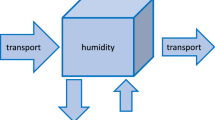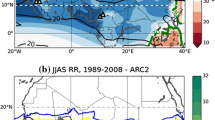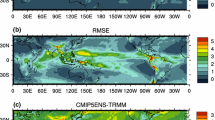Abstract
The CNRM atmospheric general circulation model Arpege-Climat is relaxed towards atmospheric reanalyses outside the 10°S–32°N 30°W–50°E domain in order to disentangle the regional versus large-scale sources of climatological biases and interannual variability of the West African monsoon (WAM). On the one hand, the main climatological features of the monsoon, including the spatial distribution of summer precipitation, are only weakly improved by the nudging, thereby suggesting the regional origin of the Arpege-Climat biases. On the other hand, the nudging technique is relatively efficient to control the interannual variability of the WAM dynamics, though the impact on rainfall variability is less clear. Additional sensitivity experiments focusing on the strong 1994 summer monsoon suggest that the weak sensitivity of the model biases is not an artifact of the nudging design, but the evidence that regional physical processes are the main limiting factors for a realistic simulation of monsoon circulation and precipitation in the Arpege-Climat model. Sensitivity experiments to soil moisture boundary conditions are also conducted and highlight the relevance of land–atmosphere coupling for the amplification of precipitation biases. Nevertheless, the land surface hydrology is not the main explanation for the model errors that are rather due to deficiencies in the atmospheric physics. The intraseasonal timescale and the model internal variability are discussed in a companion paper.













Similar content being viewed by others
References
Alexandru A, de Elia R, Laprise R, Separovic L, Biner S (2009) Sensitivity study of regional climate model simulations to large-scale nudging parameters. Mon Weather Rev 137:1666–1686
Biasutti M, Sobel AH, Camargo SJ (2009) The role of the Sahara low in summertime Sahel rainfall variability and change in the CMIP3 models. J Clim 22:5755–5771
Bielli S, Douville H, Pohl B (2010) Understanding the West African monsoon variability and its remote effects: an illustration of the grid point nudging methodology. Clim Dyn 35:159–174. doi:10.1007/s00382-009-0667-8
Bouali L, Fontaine B, Philippon N, Lémond J (2008) Performance of DEMETER calibration for rainfall forecasting purposes: application to the July–August Sahelian rainfall. J Geophys Res 113:1616–1620
Bougeault P (1985) A simple parameterization of the large-scale effects of cumulus convection. Mon Weather Rev 113:2108–2121
Cook KH, Vizy EK (2006) Coupled model simulations of the West African monsoon system: 20th and 21st century simulations. J Clim 19:3681–3703
Decharme B, Douville H (2006) Uncertainties in the GSWP-2 precipitation forcing and their impacts on regional and global hydrological simulations. Clim Dyn 27:695–713
Dirmeyer PA, Gao X, Oki T (2002) The second global soil wetness project GSWP2: science and implementation plan. IGPO publication series 37, International GEWEX Project Office, pp 65
Douville H (2009) Stratospheric polar vortex influence on Northern hemisphere winter climate variability. Geophys Res Lett 36:L18703. doi:10.1029/2009GL039334
Douville H, Chauvin F, Broqua H (2001) Influence of soil moisture on the Asian and African monsoons. Part I: mean monsoon and daily precipitation. J Clim 14:2381–2403
Douville H, Salas-Mélia D, Tyteca S (2006) On the tropical origin of uncertainties in the global land precipitation response to global warming. Clim Dyn 26:367–385. doi:10.1007/s00282-005-0088-2
Douville H, Conil S, Tyteca S, Voldoire A (2007) Soil moisture memory and West African monsoon predictability: artefact or reality? Clim Dyn 28:723–742. doi:10.1007/s00382-006-0207-8
Fontaine B, Janicot S, Moron V (1995) Rainfall anomaly patterns and wind field signals over West Africa in August (1958–1989). J Clim 8:1503–1508
Garric G, Douville H, Déqué M (2002) Prospects for improved seasonal predictions of monsoon precipitation over Sahel. Int J Climatol 22:331–345
Hourdin F, The AMMA-MIP team (2010) AMMA-model intercomparison project. Bull Am Meteor Soc 91:95–104
Huffman GJ, Adler RF, Rudolf B, Schneider U, Keehn PR (1997) The global precipitation climatology project (GPCP) combined precipitation dataset. Bull Am Meteorol Soc 78:5–20
Joly M, Voldoire A, Douville H, Terray P, Royer J-F (2007) African monsoon teleconnections with tropical SSTs: validation and evolution in a set of IPCC4 simulations. Clim Dyn 29:1–20. doi:10.1007/s00382-006-0215-8
Jones RG, Murphy JM, Noguer M (1995) Simulation of climate change over Europe using a nested regional-climate model. I: assessment of control climate, including sensitivity to location of lateral boundaries. Quart J Roy Meteorol Soc 121:1413–1449
Jung T, Palmer T, Rodwell M, Serrar S (2009) Understanding the anomalously cold European winter of 2005/06 using relaxation experiments. ECMWF technical memorandum, pp 20
Koster R, The GLACE team (2004) Regions of strong coupling between soil moisture and precipitation. Science 305:1138–1140
Leduc M, Laprise R (2008) Regional climate model sensitivity to domain size. Clim Dyn 32:833–854. doi:10.1007/s00382-008-0400-z
Leroux S, Hall NMJ (2009) On the relationship between African easterly waves and the African easterly jet. J Atm Sci 66:2303–2316
Leung LR, Mearns LO, Giorgi F, Wilby RL (2003) Regional climate research - needs and opportunities. Bull Am Meteor Soc 84:89–95
Meynadier R, Bock O, Guichard F, Boone A, Roucou P, Redelsperger JL (2010a) The West African monsoon water cycle. Part I: a hybrid water budget dataset. J Geophys Res (in press)
Meynadier R, Bock O, Gervois S, Guichard F, Redelsperger J-L, Agusti-Panareda A, Beljaars (2010b) The West African monsoon water cycle. Part II: assessment of NWP water budgets. J Geophys Res (in press)
Moron V, Philippon N, Fontaine B (2004) Simulation of West African monsoon circulation in four atmospheric general circulation models forced by prescribed sea surface temperature. J Geophys Res 109:D24105. doi:10.1029/2004JD004760
Moufouma-Okia W, Rowell DP (2010) Impact of soil moisture initialisation and lateral boundary conditions on regional climate model simulations of the West African Monsoon. Clim Dyn 35:213–229. doi: 10.1007/s00382-009-0638-0
Noilhan J, Planton S (1989) A simple parameterization of land surface processes for meteorological models. Mon Weather Rev 117:536–549
Pohl B, Janicot S, Fontaine B, Marteau R (2009) Implication of the Madden–Julian oscillation in the 40-day variability of the West African monsoon. J Clim 22:3769–3785
Ruti PM, Dell’ Aquila A (2008) The 20th century AEJ and AEWs in reanalyses and IPCC simulations. AMMA report
Salas y Mélia D, Chauvin F, Déqué M, Douville H, Guérémy JF, Marquet P, Planton S, Royer J-F, Tyteca S (2005) Description and validation of CNRM-CM3 global coupled climate model, note de Centre du GMGEC 103, December 2005
Separovic L, de Elia R, Laprise R (2008) Reproducible and irreproducible components in ensemble simulations with a regional climate model. Mon Weather Rev 136:4942–4961
Seth A, Giorgi F (1998) The effects of domain choice on summer precipitation simulation and sensitivity in a regional climate model. J Clim 11:2698–2712
Simmons A, Uppala SM, Dee D, Kobayashi S (2007) ERA-interim: new ECMWF reanalysis products from 1989 onwards. ECMWF Newsl 110:25–35
Sperber KR, Palmer TN (1996) Inter-annual tropical rainfall variability in general circulation model simulations associated with the atmospheric model intercomparison project. J Clim 9:2727–2750
Sultan B, Janicot S, Diedhiou A (2003) The West African monsoon dynamics. Part I: documentation of intraseasonal variability. J Clim 16:3389–3406
Sylla MB, Coppola E, Mariotti L, Giorgi F, Ruti PM, Dell’Aquila A, Bi X (2010) Multiyear simulation of the African climate using a regional climate model (RegCM3) with the high resolution ERA-interim reanalysis. Clim Dyn 35:231–247. doi:10.1007/s00382-009-0613-9
Uppala SM, Kallberg PW, Simmons AJ et al (2005) The ERA-40 re-analysis. Q J R Meteor Soc 131:2961–3012
Vanvyve E, Hall N, Messager C, Leroux S, van Ypersele JP (2008) Internal variability in a regional climate model over West Africa. Clim Dyn 30:191–202
Wolter K, Timlin MS (1993) Monitoring ENSO in COADS with a seasonally adjusted principal component index. In: 17th climate diagnostics workshop, Norman, OK, pp 52–57
Yoshimura K, Kanamitsu M (2008) Dynamical global downscaling of global reanalysis. Mon Weather Rev 136:2983–2998
Acknowledgments
Based on a French initiative, AMMA was built by an international scientific group and is currently funded by a large number of agencies, especially from France, the United Kingdom, the United States, and Africa. It has been the beneficiary of a major financial contribution from the European Community’s Sixth Framework Research Programme. (Detailed information on scientific coordination and funding is available online at the AMMA International Web site at http://www.amma-international.org). ERA40 data were downloaded from http://www.ecmwf.int. GPCP data were downloaded from http://www.cdc.noaa.gov. Thanks are also due to the French ANR IRCAAM project for supporting the development of the nudging technique, and to S. Bielli, F. Chauvin, J-F. Guérémy, F. Guichard, J-P. Lafore, J-L. Redelsperger, R. Roehrig and A. Voldoire for helpful discussions concerning this work. The authors are also very grateful to M. Déqué for his support in using the Arpege-Climat model, and to O. Bock, R. Meynadier and P. Roucou for the computation of the atmospheric water budget.
Author information
Authors and Affiliations
Corresponding author
Appendix: Methodology for the computation of the moisture fluxes
Appendix: Methodology for the computation of the moisture fluxes
Calculating the atmospheric water budget over a given area is not an easy task because of several methodology problems that can arise at different stages of the computation (Meynadier et al. 2010a):
-
(1)
reanalyses do not offer the possibility to obtain realistic closure terms for the atmospheric water vapor, because of data assimilation during the integration of numerical weather models.
-
(2)
tropical rainfall fields in atmospheric models are subject to huge uncertainties because of the perfectible parameterization of deep convective processes.
-
(3)
daily and even 6-hourly model outputs sub-sample the diurnal cycle, which may lead to wrong representations of, e.g. afternoon tropical storms.
-
(4)
vertical integration of, e.g. moisture fluxes, are somewhat uncertain because they are often based on a rather low number of pressure levels, interpolated from the model sigma levels.
When working with a GCM, one is still submitted to the errors linked to point (2). It is however possible to estimate to what extent points (3) and (4) may contribute to wrong estimates of the different terms of the equation for water vapor closure. To that end, we computed daily vertically integrated moisture fluxes based on daily outputs interpolated on similar pressure levels as those available for ERA40 reanalyses, and alternatively, moisture fluxes integrated on the model sigma levels at each time step (30 min here). In other words, the first method is that applied on reanalyzed data, but the second one offers better estimates of the moisture fluxes and theoretically allows for a perfect water vapor closure in each grid point. The results are shown in Figs. 14 (for the Sahel) and 15 (over Africa).
a Scatter plot intersecting the pentad mean moisture divergence (mm day−1) over the Sahel (10°N–20°N, 20°W–20°E) computed with daily pressure fields (abscissa) and with vertical integrations on the model levels at each model time step (ordinates), JJAS 1971–2000. The common variance between the two series is labeled on the figure. b Seasonality of moisture divergence according to daily pressure fields (blue curve) and 30-min-resolution fields available on sigma levels (red curve) for each pentad of the season. Bars difference between the two methods of vertical integration (c) As (b) but for seasonal means, period 1971–2000
a Seasonal mean moisture fluxes integrated over the air column (vectors) and moisture divergence (shading), period JJAS 1971–2000. b Difference between the two methods of vertical integrations. Significance tested and shown as for Fig. 2
Figure 14 shows that, over the Sahel, the two methods lead to a difference of 2 mm day−1. Daily fields over-estimate moisture divergence over the Sahel. The error is almost constant from early June to late September (Fig. 14b) and, to a lesser extent, from 1 year to another (Fig. 14c). For comparison purposes, the difference between ERA40 rainfall and GPCP estimates, shown on Fig. 3 to be rather marked over the region, is 0.5 mm day−1. The methodology for the computation of moisture fluxes is thus of primary importance, and has a first order impact for the water vapor closure term.
Figure 15 shows the JJAS climatological integrated moisture fluxes and divergence for each grid point over Africa, and the error due to the computation method at each grid point. Note that the color scale is the same for the seasonal mean field and the differences between the two computation methods. The model climatology (Fig. 15a) shows the well-known features of large-scale atmospheric circulation over Africa, with inter-tropical moisture convergence located north of the equator and the very strong southerly moisture fluxes related to the Indian monsoon and found over the western Indian Ocean. Errors (Fig. 15b) confirm that moisture divergence is over-estimated over the Sahel when daily pressure fields are used. On the contrary, enhanced moisture convergence takes place over the Guinean belt. Daily pressure fields tend thus to exaggerate the model climatology.
For these reasons, all figures presented in this paper result of moisture fluxes calculated at the model time step and integrated on sigma levels. Errors nonetheless persist when comparisons with reanalyses are performed, because vertically integrated moisture fluxes are not available for these datasets.
Rights and permissions
About this article
Cite this article
Pohl, B., Douville, H. Diagnosing GCM errors over West Africa using relaxation experiments. Part I: summer monsoon climatology and interannual variability. Clim Dyn 37, 1293–1312 (2011). https://doi.org/10.1007/s00382-010-0911-2
Received:
Accepted:
Published:
Issue Date:
DOI: https://doi.org/10.1007/s00382-010-0911-2






